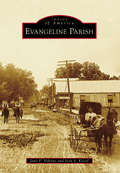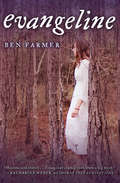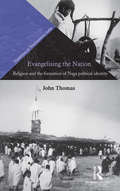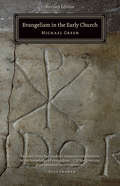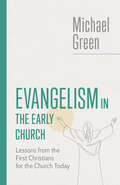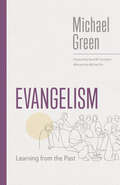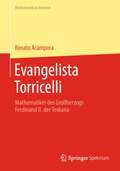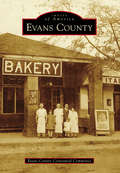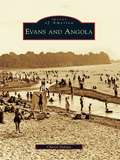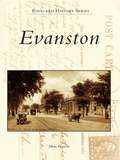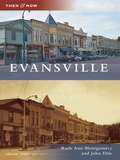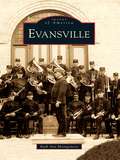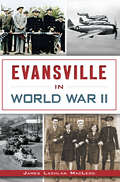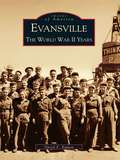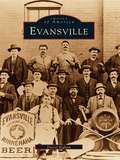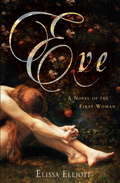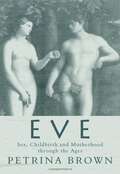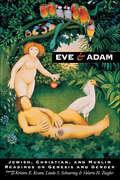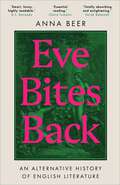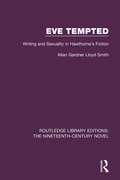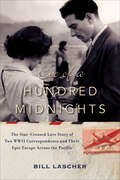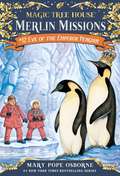- Table View
- List View
Evangeline Parish
by Jean S. Kiesel Jane F. VidrineEvangeline Parish is located near the center of Louisiana, between the prairies and wetlands of the south and the hills and piney woods of the north. Culturally, too, it embraces both the French south and the English north. Evangeline is relatively young among the parishes of Louisiana, having been carved from the western portion of St. Landry in 1910. It is named for Evangeline, the heroine of Longfellow's epic poem about the exile of the Acadians, many of whose descendants reside in Louisiana. Today, the people of Evangeline Parish remain close to the land, earning their livelihood from agriculture and forestry or small businesses. From outdoor recreation at Chicot State Park to the Courir de Mardi Gras in Mamou and Basile, and all the festivals in between, they know how to pass a good time.
Evangeline: A Novel
by Ben FarmerA young woman sets out on an epic journey across colonial America in a &“tale of love and fortitude. Simply riveting&” (Keith Donohue, New York Times–bestselling author). &“Based on the poem of the same name by Longfellow, Evangeline tells the story of the Great Upheaval, the forcible removal of the French Catholic Acadians from their lands in present-day Nova Scotia by the British. . . . Life is breathed into this tragic historical event by showing how it affected the lives of individuals, most particularly Evangeline and Gabriel, young lovers separated on the night before their wedding&” (Historical Novel Society). Heartbroken but determined, Evangeline—along with illegal trapper Bernard Arseneau and priest Felician Abadie—sets out on a ten-year journey to the French-Spanish colony of Louisiana to seek her long-lost love. Evangeline&’s epic quest to find Gabriel brings her and her companions across North America&’s colonial wilderness, through the French and Indian War, and into New Orleans&’ rebellion against Spanish rule. The influence of Evangeline can still be found at every stop of her epic journey. &“Majestic and stately as Conrad Richter&’s Awakening Land Trilogy, Evangeline is a big book from a big mind.&” —Katharine Weber, author of Still Life with Monkey &“A historical romance written in unadorned prose, Farmer&’s Evangeline will satisfy readers who allow themselves to swoon, who enjoy sentimentality . . . A kind of fiction that&’s underrepresented in U.S. bookstores.&”—ForeWord Magazine &“Farmer does a yeoman&’s job in setting the poem in prose . . . It&’s a grand tale told by a wonderful storyteller.&” —Owen Sound Sun Times
Evangelising the Nation: Religion and the Formation of Naga Political Identity (Transition in Northeastern India)
by John ThomasNortheast India has witnessed several nationality movements during the 20th century. The oldest and one of the most formidable has been that of the Nagas — inhabiting the hill tracts between the Brahmaputra river in India and the Chindwin river in Burma (now Myanmar). Rallying behind the slogan, ‘Nagaland for Christ’, this movement has been the site of an ambiguous relation between a particular understanding of Christianity and nation-making. This book, based on meticulous archival research, traces the making of this relation and offers fresh perspectives on the workings of religion in the formation of political and cultural identities among the Nagas. It tracks the transmutations of Protestantism from the United States to the hill tracts of Northeast India, and its impact on the form and content of the nation that was imagined and longed for by the Nagas. The volume also examines the role of missionaries, local church leaders, and colonial and post-colonial states in facilitating this process. Lucidly written and rigorous in its analyses, this book will be of interest to scholars and researchers of South Asian history, religion, political science, sociology and social anthropology, and particularly those concerned with Northeast India.
Evangelism in the Early Church: Lessons From The First Christians For The Church Today (The\eerdmans Michael Green Collection (emgc) Ser.)
by Michael GreenNow a modern classic, Michael Green's Evangelism in the Early Church provides a comprehensive look at the ways the first Christians -- from the New Testament period up until the middle of the third century -- worked to spread the good news to the rest of the world.In describing life in the early church, Green explores crucial aspects of the evangelistic task that have direct relevance for similar work today, including methods, motives, and strategies. He assesses the strengths and weaknesses of the evangelistic approaches used by the earliest Christians, and he also considers the obstacles to evangelism, using outreach to Gentiles and to Jews as examples of differing contexts for proclamation. Carefully researched and frequently quoting primary sources from the early church, this book will both show contemporary readers what can be learned from the past and help renew their own evangelistic vision.
Evangelism in the Early Church: Lessons from the First Christians for the Church Today (The Eerdmans Michael Green Collection)
by Michael GreenNow a modern classic, Michael Green&’s Evangelism in the Early Church shows how the first Christians worked to spread the good news to the rest of the world. Studying the New Testament and church fathers, Green explores the earliest methods, motives, and strategies of spreading the good news. He also considers the obstacles to evangelism, using outreach to Gentiles and to Jews as examples of differing contexts for proclamation. Thoroughly informed by primary sources, this book will help contemporary readers learn from the past and renew their own evangelistic vision.
Evangelism: Learning from the Past (The Eerdmans Michael Green Collection)
by Michael GreenMichael Green&’s valedictory work: a personal history of evangelismBeyond his prolific academic career, Michael Green is fondly remembered for his commitment to sharing the gospel with everyone. His passion for evangelism, the heart of his life and work, shines through in Evangelism: Learning from the Past, his last manuscript before his passing in 2019.Green narrates how evangelists spread the good news, starting with first evangelist, Jesus, and his apostles. He then moves through the early church, the Middle Ages, the Reformation, and Revival movements. The book culminates with Green&’s reflections on his own decades-spanning career in evangelism and how he adapted the timeless truths of the gospel amid the major cultural shifts of the twentieth century. Throughout the narrative, he focuses on what we can learn from evangelists through history to inform our own practice today. To this end, each chapter concludes with questions to encourage reflection.Those who have been moved by Green&’s work will treasure this deeply personal final addition to his extensive oeuvre. Evangelism: Learning from the Past will offer inspiration and encouragement to all evangelical Christians looking to revitalize and contextualize their work in proclaiming the good news to all.
Evangelista Torricelli: Mathematiker des Großherzogs Ferdinand II. der Toskana (Mathematik im Kontext)
by Renato AcamporaDie meisten Nichtmathematiker werden Torricelli durch das nach ihm benannte Ausflussgesetz kennen, wonach die Geschwindigkeit eines aus einem Gefäss austretenden Wasserstrahls proportional zur Quadratwurzel aus der Füllhöhe ist, ebenso wie durch seinen Nachweis des Luftdrucks mithilfe seines Vakuumexperiments. Viel bedeutender aber sind seine Leistungen auf dem Gebiet der Mathematik als virtuoser Vertreter von Cavalieris umstrittener Indivisiblenmethode, wobei er seine Ergebnisse aber stets mit Beweisen nach der allgemein anerkannten „Art der Alten“ absicherte. Auf diese Weise gelang ihm die Quadratur der Parabeln und Hyperbeln höherer Ordnung, der Zykloide, der logarithmischen Spirale (ebenso wie deren Rektifikation) und die Bestimmung der Schwerpunkte zahlreicher ebener und räumlicher Figuren.
Evangelizing the Chosen People: Missions to the Jews in America, 1880-2000
by Yaakov ArielWith this book, Yaakov Ariel offers the first comprehensive history of Protestant evangelization of Jews in America to the present day. Based on unprecedented research in missionary archives as well as Jewish writings, the book analyzes the theology and activities of both the missions and the converts and describes the reactions of the Jewish community, which in turn helped to shape the evangelical activity directed toward it.Ariel delineates three successive waves of evangelism, the first directed toward poor Jewish immigrants, the second toward American-born Jews trying to assimilate, and the third toward Jewish baby boomers influenced by the counterculture of the Vietnam War era. After World War II, the missionary impulse became almost exclusively the realm of conservative evangelicals, as the more liberal segments of American Christianity took the path of interfaith dialogue.As Ariel shows, these missionary efforts have profoundly influenced Christian-Jewish relations. Jews have seen the missionary movement as a continuation of attempts to delegitimize Judaism and to do away with Jews through assimilation or annihilation. But to conservative evangelical Christians, who support the State of Israel, evangelizing Jews is a manifestation of goodwill toward them.
Evanira Mendes: A Voice from the Brazilian Folklore Movement
by Eric A. GalmThis compilation of Evanira Mendes’s biography and translated publications offers for the first time in English an opportunity to revisit the music and culture of 1950s Brazil. Examining the trajectory of the Brazilian folklore movement, this book provides a new perspective on contemporary accounts that have overlooked the participation of women scholars from that era and seeks to grant Mendes the recognition she so richly deserves. Growing up on a farm in rural São Paulo State, Evanira Mendes (1929–2022) exhibited an early love of folklore, cultivated through the stories, songs, and gossip of wandering travelers in exchange for food and shelter. As she got older, she entered the Conservatório Dramático e Musical de São Paulo to study piano, but her love of folklore persisted, and she was invited to work in the school’s folklore archive and later as a folklore researcher for the São Paulo Folklore Commission from 1949 to 1959. There, she won awards including the national Sílvio Romero Medal; won second place in a national folklore monograph competition; helped to organize the folklore pavilion at the IV° Centenário de São Paulo celebration; and worked closely with important names of the era. Despite these accomplishments, she has essentially been forgotten. This book follows Evanira Mendes’s experiences working as a field researcher as part of the São Paulo Folklore Commission, her participation and organization at national and international folklore conferences, her participatory research in Afro-Brazilian community dances and observation and critique of Brazilian modern artistic expression in the theaters of São Paulo, and her work as editor of the folklore page and later weekly columnist in the Correio Paulistano newspaper. Her first-person accounts of fieldwork and participation in folklore courses are supplemented by separate published accounts from various sources, helping to compile a comprehensive portrait of music and culture in São Paulo and Brazil from that era.
Evans County
by Evans County Centennial CommitteeHow many counties can boast of having Georgia's first female sheriff and a town known as the "fruitcake capital of the world"? These distinctions, and many others, make Evans County unique. Evans, the 150th of Georgia's 159 counties, was created in 1914 from parts of Bulloch and Tattnall Counties. Its development was closely linked with agriculture and the growth of railroads, and the area towns of Daisy, Claxton, Hagan, and Bellville all began as train depots. Although Evans is one of Georgia's later and smaller counties, it offers a fine example of rural progress and friendly communities. As Evans County enters its centennial year, there is much to celebrate.
Evans and Angola
by Cheryl DelanoIncorporated in 1821, the area that is now the town of Evans saw its first permanent settlers just prior to the War of 1812. The village of Angola developed later with the establishment of the railroad, which also brought industry, most notably the internationally known Emblem Bicycle Company. Lake Erie also drew visitors and residents to the area. The miles of shoreline were home to summer camps for adults, as well as children, and the wealthiest families in the city of Buffalo built their summer homes there. Prominent among these estates was Graycliff, the summer home of Darwin Martin, designed by Frank Lloyd Wright. William H. Carrier, known as the "Father of Air-Conditioning" and the town's most famous resident, was born and educated in Evans and graduated from Angola High School in 1894.
Evanston (Postcard History)
by Mimi M. PetersonEnjoy a trip through historic Evanston. See how Davis Street and Sherman and Orrington Avenues appeared around the beginning of the 20th century. Learn how Fountain Square has evolved and how the Merrick Rose Garden is connected. See Northwestern University as it was founded, along with early Evanston's lakefront, city hall, library, and post office. Many of the buildings shown in this book are still standing, while others have been demolished. In some postcard views the stately elm trees of later decades are seen as saplings. The Library Plaza Hotel, North Shore Hotel, and Georgian Hotel are here as well, along with the historic schools, churches, train depots, and, of course, Grosse Point Lighthouse, which all helped shape the city in its formative years.
Evansville
by John Ehle Ruth Ann MontgomeryEvansville, settled in 1839, developed as an important agricultural trade center. Log cabins, farms, and small industries were built, and the population grew from less than 10 families in the beginning to nearly 5,000 people in 2009. Then and Now: Evansville is a unique look at how the community has changed from the 1900s to today. Ruth Ann Montgomery, author of Images of America: Evansville for Arcadia Publishing, is Evansville's historian. John Ehle, an Evansville resident for many years, has conducted interviews with local veterans and those who lived through the Great Depression.
Evansville (Images of America)
by Ruth Ann MontgomeryThe Evansville area was settled in 1839 and the village platted in 1855 on the hopes that the railroad would come through. It was named for Evansville's first physician, Dr. John M. Evans. When the railroad arrived in 1863, Evansville's prosperity was assured. There were many opportunities for growth in agriculture, manufacturing, and commerce. The Chicago and Northwestern Railroad offered passenger and freight service to major markets in Chicago and the West. Local farmers found national and international markets for their prizewinning livestock and produce. The Evansville Seminary and a strong public school system provided educational opportunities. Literary societies, churches, and veterans groups provided social activities. Talented 19th- and 20th-century architects and craftsmen were responsible for the fine collection of architectural styles in Evansville.
Evansville in World War II (Military Ser.)
by James Lachlan MacleodDuring World War II, the city of Evansville manufactured vast amounts of armaments that were vital to the Allied victory. The Evansville Ordnance Plant made 96 percent of all .45-caliber ammunition used in the war, while the Republic Aviation Plant produced more than 6,500 P-47 Thunderbolts--almost half of all P-47s built during the war. At its peak, the local shipyard employed upward of eighteen thousand men and women who forged 167 of the iconic Landing Ship Tank vessels. In this captivating and fast-paced account, University of Evansville historian James Lachlan MacLeod reveals the enormous influence these wartime industries had on the social, economic and cultural life of the city.
Evansville: The World War II Years (Images of America)
by Darrel E. BighamWorld War II changed the face of Evansville, Indiana. In December 1941, the city was still recovering from the Great Depression, yet within three months, a series of blockbusterannouncements transformed the region. Several corporations received major defense contracts to manufacture parts and ammunitions, while two new installations were launched: a shipyard to construct Landing Ship Tanks and a factory to manufacture P-47 airplanes. Industrial employment rose dramatically, producing social, economic, and racial tensions as thousands of newcomers poured into a city that lacked adequate housing and publicfacilities. The citizens of Evansville persevered, and most workers stayed following the end of the war. One federal official commented that the city--not just its many defense plants--deserved the coveted Army-Navy "E" (for excellence) award.
Evansville: The World War Ii Years (Images of America)
by Darrel BighamAs we approach a new century and a new millennium, we should consider how people in American communities dreamed about and participated in the coming of the twentieth century 100 years ago. The focus of this work is Evansville--100 years ago the only emerging metropolis between Louisville and St. Louis, and then, as now, the radial center of a hinterland stretching in all directions from 75 to 125 miles. The book illustrates how the city landscape changed because of the early industrial era, how people made a living, how people related toeach other, and how they spent their leisure time. About one-fifth of the images in this collection focus on the residents of the Evansville region; the Tri-State of southwestern Indiana, western Kentucky, and southern Illinois, which has been Evansville'sservice area since the 1850s.
Eve
by Elissa ElliottBONUS: This edition contains an Eve discussion guide.In this mesmerizing debut novel, Elissa Elliott blends biblical tradition with recorded history to put a powerful new twist on the story of creation's first family. Here is Eve brought to life in a way religion and myth have never allowed-as a wife, a mother, and a woman. With stunning intimacy, Elliott boldly reimagines Eve's journey before and after the banishment from Eden, her complex marriage to Adam, her troubled relationship with her daughters, and the tragedy that would overcome her sons, Cain and Abel. From a woman's first awakening to a mother's innermost hopes and fears, from moments of exquisite tenderness to a climax of shocking violence, Eve explores the very essence of love, womanhood, faith, and humanity.
Eve
by Petrina BrownIn "Eve", Petrina Brown explores the influence of religion and folklore on sex and childbirth and their impact on women. A natural storyteller, she has researched customs and ceremonies from around the world, revealing extraordinary advice that has been followed for fertility, contraception and abortion. In the final chapter she relates celebrities experiences of childbirth, both mothers and fathers. Eve is an insightful and compelling journey through women's history - from prehistoric Egypt to the present day.
Eve & Adam: Jewish, Christian, and Muslim Readings on Genesis and Gender
by Kristen E. Kvam, Linda S. Schearing and Valarie H. Ziegler"The editors have performed a great service in making widely available a documentary history of the interpretation of the Eve and Adam story." —Publishers Weekly"This fascinating volume examines Genesis 1-3 and the different ways that Jewish, Christian, and Muslim interpreters have used these passages to define and enforce gender roles. . . . a 'must' . . . " —Choice"Wonderful! A marvelous introduction to the ways in which the three major Western religious traditions are both like, and unlike one another." —Ellen Umansky, Fairfield UniversityNo other text has affected women in the western world as much as the story of Eve and Adam. This remarkable anthology surveys more than 2,000 years of Jewish, Christian, and Muslim commentary and debate on the biblical story that continues to raise fundamental questions about what it means to be a man or to be a woman. The selections range widely from early postbiblical interpretations in the Apocrypha and Pseudepigrapha to the Qur'an, from Thomas Aquinas to medieval Jewish commentaries, from Christian texts to 19th-century antebellum slavery writings, and on to pieces written especially for this volume.
Eve Bites Back: An Alternative History of English Literature
by Anna BeerWarned not to write – and certainly not to bite – these women put pen to paper anyway and wrote themselves into history. From the fourteenth century through to the present day, women who write have been understood as mad, undisciplined or dangerous. Female writers have always had to find ways to overcome or challenge these beliefs. Some were cautious and discreet, some didn&’t give a damn, but all lived complex, eventful and often controversial lives. Eve Bites Back places the female contemporaries of Chaucer, Shakespeare and Milton centre stage in the history of literature in English, uncovering stories of dangerous liaisons and daring adventures. From Julian of Norwich, Margery Kempe, Aemilia Lanyer and Anne Bradstreet, to Aphra Behn, Mary Wortley Montagu, Jane Austen and Mary Elizabeth Braddon, these are the women who dared to write.
Eve Tempted: Writing and Sexuality in Hawthorne's Fiction (Routledge Library Editions: The Nineteenth-Century Novel #19)
by Allan Gardner Lloyd SmithFirst published in 1984, this book offers a unique interpretation of Hawthorne’s work, making use of perspectives opened up by Derrida in his work on Rousseau. It offers a psycho-biography of the author as discoverable in the texts and avoids a simplistic Freudian analysis. In doing so, it illuminates the work and re-opens Hawthorne’s texts to creative discussion. This book will be of interest to those studying 19th century literature.
Eve of a Hundred Midnights: The Star-Crossed Love Story of Two WWII Correspondents and Their Epic Escape Across the Pacific
by Bill LascherThe unforgettable true story of two married journalists on an island-hopping run for their lives across the Pacific after the Fall of Manila during World War II—a saga of love, adventure, and danger.On New Year’s Eve, 1941, just three weeks after the attack on Pearl Harbor, the Japanese were bombing the Philippine capital of Manila, where journalists Mel and Annalee Jacoby had married just a month earlier. The couple had worked in China as members of a tight community of foreign correspondents with close ties to Chinese leaders; if captured by invading Japanese troops, they were certain to be executed. Racing to the docks just before midnight, they barely escaped on a freighter—the beginning of a tumultuous journey that would take them from one island outpost to another. While keeping ahead of the approaching Japanese, Mel and Annalee covered the harrowing war in the Pacific Theater—two of only a handful of valiant and dedicated journalists reporting from the region.Supported by deep historical research, extensive interviews, and the Jacobys’ personal letters, Bill Lascher recreates the Jacobys’ thrilling odyssey and their love affair with the Far East and one another. Bringing to light their compelling personal stories and their professional life together, Eve of a Hundred Midnights is a tale of an unquenchable thirst for adventure, of daring reportage at great personal risk, and of an enduring romance that blossomed in the shadow of war.
Eve of the Emperor Penguin
by Mary Pope Osborne Sal MurdoccaThe #1 bestselling chapter book series of all time celebrates 25 years with new covers and a new, easy-to-use numbering system!Jack and Annie arrive on the one continent they haven’t visited before: Antarctica! What can they hope to learn about happiness in such a barren place? Only the penguins know for sure…Jack and Annie are about to find out!Formerly numbered as Magic Tree House #40, the title of this book is now Magic Tree House Merlin Mission #12: Eve of the Emperor Penguin.Did you know that there’s a Magic Tree House book for every kid?Magic Tree House: Adventures with Jack and Annie, perfect for readers who are just beginning chapter booksMerlin Missions: More challenging adventures for the experienced readerSuper Edition: A longer and more dangerous adventureFact Trackers: Nonfiction companions to your favorite Magic Tree House adventuresHave more fun with Jack and Annie at MagicTreeHouse.com
Eve of the Emperor Penguin (Magic Tree House Merlin Missions #12)
by Mary Pope Osborne Sal MurdoccaJACK AND ANNIE continue their quest for the secrets of happiness--secrets they need to save Merlin. This time, the Magic Tree House takes them to the one continent they haven't visited before: Antarctica! What can they hope to learn about happiness in such a barren place? Only the penguins know for sure . . . Jack and Annie are about to find out! From the Hardcover edition.
